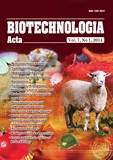ISSN 2410-7751 (Print)
ISSN 2410-776X (Online)

"Biotechnologia Acta" v. 7, no 1, 2014
Р. 54-59, Bibliography 14, Russian
Universal Decimal classification: 577.27:578.81+[616.931:615.279]
https://doi.org/10.15407/biotech7.01.054
Oliinyk O. S., Kaberniuk A. A., Kolibo D. V., Komisarenko S. V.
Palladin Institute of Biochemistry of National Academy of Sciences of Ukraine, Kyiv, Ukraine
Diphtheria toxin is an exoantigen of Corynebacterium diphtheriae that inhibits protein synthesis and kills sensitive cells. The aim of this study was to obtain human recombinant single-chain variable fragment (scFv) antibodies against receptor-binding B subunit of diphtheria toxin.
12 specific clones were selected after three rounds of a phage display naїve (unimmunized) human antibody library against recombinant B-subunit. scFv DNA inserts from these 12 clones were digested with MvaI, and 6 unique restriction patterns were found. Single-chain antibodies were expressed in Escherichia coli XL1-blue. The recombinant proteins were characterized by immunoblotting of bacterial extracts and detection with an anti-E-tag antibody. The toxin B-subunit-binding function of the single-chain antibody was shown by ELISA. The affinity constants for different clones were found to be from 106 to 108 М–1.
Due to the fact, that these antibody fragments recognized epitopes in the receptor-binding Bsubunit of diphtheria toxin, further studies are interesting to evaluate their toxin neutralization properties and potential for therapeutic applications. Obtained scFv-antibodies can also be used for detection and investigation of biological properties of diphtheria toxin.
Key words: scFv-antibodies, diphtheria toxin, phage display, naive human recombinant antibody library.
© Palladin Institute of Biochemistry of National Academy of Sciences of Ukraine, 2014
References
1. Atkinson W., Wolfe S., Hamborsky J. Epidemiology and Prevention of Vaccine-Preventable Diseases. 12th ed., second printing. Washington DC: Public Health Foundation. 2012, 324 p.
2. Honjo T., Nishizuka Y., Hayaishi O. Diphtheria toxin-dependent adenosine diphosphate ribosylation of aminoacyl transferase II and inhibition of protein synthesis. J. Biol. Chem. 1968. 243(12), 3553–3555.
3. Rolf J. M. Gaudin H. M., Eidels L. Localization of the diphtheria toxin receptor-binding domain to the carboxyl-terminal Mr approximately 6000 region of the toxin. J. Biol. Chem. 1990, 265(13), 7331–7337.
4. Zucker D. R., Murphy J. R. Monoclonal antibody analysis of diphtheria toxin-I. Localization of epitopes and neutralization of cytotoxicity. Mol. Immunol. 1984, 21(9), 785–793.
https://doi.org/10.1016/0161-5890(84)90165-2
5. Valiakina T. I., Lakhtina O. E., Komaleva R. L., Simonova M. A., Samokhvalova L. V., Shoshina N. S., Kalinina N. A., Rubina A. Iu., Filippova M. A., Vertiev Iu. V., Grishin E. V. Production and Characteristics of Monoclonal Antibodies to the Diphtheria Toxin. Bioorg Khim. 2009, 35(5), 618–28. (In Russian).
6. Naiditch M. J., Bower A. G. Diphtheria; a study of 1,433 cases observed during a ten-year period at the Los Angeles County Hospital. Amer. J. Med. 1954, 17(2), 229–245.
7. Zaіtse V. E. M., Sviridov V. V., Titova N. G., Lebedev V. S., Garipova M. I. Antitoxic properties of monoclonal antibodies against diphtheria toxin. Mol. Gen. Microbiol. Virusol. 1985, N 2, 37–41.
8. Oliinyk O. S., Labyntsev A. J., Korotkevych N. V., Kolibo D. V., Komisarenko S. V. Study on toxin-neutralization properties of recombinant singlechain variable antibody’s fragments against diphtheria toxin В subunit. Biopolymers and Сell. 2009, 24(4), 315–318. (In Ukrainian).
9. Oliinyk O. S., Kaberniuk A. A., Redchuk T. A., Kolibo D. V., Komisarenko S. V. Construction of bifunctional molecules specific to antigen and antibody’s Fc-fragment by fusion of scFv-antibodies with staphylococcal protein A. Biopolymers and Сell. 2009, 25(3), 245–249. (In Ukrainian).
10. Kaberniuk A. A., Oliinyk O. S., Redchuk T. A., Romaniuk S. I., Kolibo D. V., Komisarenko S. V. Cloning and expression of diphtheria toxin’s recombinant subunits of Corynebacterium diphtheriae in Escherichia coli. Dop. NAN Ukrainy. 2008, V. 3, 160–166. (In Ukrainian).
11. Bobrovnik S. A. Komisarenko S. V., Ilyina L. V. Novel and simple ELISA-based method for antibody affinity determination. Ukr. Biokhim. Zh. 2005, 77(2), 169–74. (In Ukrainian).
12. Pucca M. B., Zoccal K. F., Roncolato E. C., Bertolini T.B., Campos L. B., Cologna C. T., Faccioli L. H., Arantes E. C., Barbosa J. E. Serrumab: a human monoclonal antibody that counters the biochemical and immunological effects of Tityus serrulatus venom. J. Immunotoxicol. 2012, 9(2), 173–183.
https://doi.org/10.3109/1547691X.2011.649220
13. Funayama J. C., Pucca M. B., Roncolato E. C., Bertolini T. B., Campos L. B., Cologna C. T., Faccioli L. H., Arantes E. C., Barbosa J. E. Production of human antibody fragments binding to melittin and phospholipase A2 in Africanised bee venom: minimising venom toxicity. Basic Clin. Pharmacol. Toxicol. 2012, 110(3), 290–297.
https://doi.org/10.1111/j.1742-7843.2011.00821.x
14. Arya P., Ponmariappan S., Singh L., Prasad G. B. Antibodies against recombinant catalytic domain of lethal toxin of Clostridium sordellii neutralize lethal toxin toxicity in HeLa cells. Prot. Pept. Lett. 2013, 20(2), 205–212.
https://doi.org/10.2174/092986613804725325

